Guest Author: James Ormiston
Palaeontology MSci Graduate / Palaeoartist
‘Herpetón‘ – Noun, from the Ancient Greek ἑρπετόν meaning:
A four-legged animal, or an animal that creeps, e.g. a lizard or snake
Gather ‘round ye rock hounds and I shall tell ye the tale of the slippery serpent of the Severn. ‘tis a tale of obscure mystery, war, obsessive Victorian collectors and a headless reptile over 200 million years old. That reptile is Pachystropheus.
In the mid-2010s, as a palaeontology student here at Bristol, I stumbled upon an unassuming chunk of pyrite (“Fool’s Gold”) at the famous local fossil site of Aust Cliff on the Severn Estuary. It glittered nicely in the afternoon sun and, on picking it up and turning it around, I discovered a fossil bone. It was a small, delicate vertebra with a long spine coming out of it. I took it back to the department and showed it to Mike Benton, who identified it as Pachystropheus, a diagnosis echoed by Darren Naish some years later.
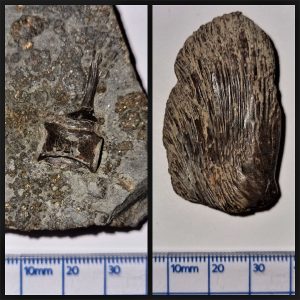
As it turned out, Pachystropheus’ jumbled-up remains are not uncommon in the Late Triassic rocks surrounding Bristol. But despite being known about for almost two centuries and appearing at multiple sites in and outside Britain, Pachystropheus is a rather cryptic critter!
The Long Silence
Material eventually referred to as Pachystropheus appears in the collections of Charles Moore, an amateur geologist from Ilminster during the Victorian Era. Moore was one of the first fossil hunters to employ “bulk collecting”: gathering a massive amount of fossil-containing rock and picking through it to see what he could find.
In 1858 he came across a large deposit belonging to the Rhaetic Beds at Holwell near Frome. The Rhaetic Beds were Triassic in age (just over 200 million years old) and named after the Rhaetic Alps of central Europe, which are themselves named after the ancient Raeti tribes. Today these rocks are referred to as the Penarth Group.
Back in the 1850s these layers had only recently been described on the continent and Moore was keen to investigate them in Britain. He knew that rock of the Rhaetic Beds was rich in fossils, and upon discovering the sheer amount of it at Holwell he asked a local farmer if he could buy some. The farmer supposedly said that there was much better gravel closer to Moore’s home in Bath, almost 20 miles away, but he insisted it was adequate for his purposes and paid 55 shillings (about £170) for 3 tons which were transported by horse and cart.
He spent 3 years picking through this massive rock pile and, according to records, at the end of it he had recovered a MILLION fossils from the Holwell haul alone. His collection was so vast that he opened a free public museum in Bath displaying his specimens, many of which came from quarries and mine shafts long since closed. Among this prehistoric menagerie were bones belonging to a reptile then called Ryosteus oweni. As hinted at by the species name, R. oweni was described by the famous palaeontologist and anatomist Richard Owen in the 1840s. He, rather boldly, based this on a single vertebra found at another Rhaetic Bed exposure at Aust Cliff…a vertebra which, though apparently ending up in the private collection of someone in Hotwells called James Johnson, disappeared into the ether and sadly has no accompanying illustration for us to look at.
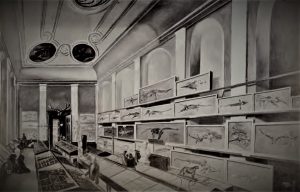
Almost a century later, Erika von Huene resurrected research on this obscure reptile. Erika’s father Friedrich was renowned for his work on extinct vertebrates at the University of Tübingen, Germany. Erika only published a handful of papers during her career due to various socio-political factors including the Nazis’ harsh restrictions on research, the outbreak of the Second World War, and the existing glass ceiling of a conservative, male-dominated academia. But her father encouraged her and was an ardent anti-Nazi; he helped one of his mentees of Jewish descent, the palaeoneurology pioneer Tilly Edinger, escape the country in 1939.
Among Erika’s few publications was her 1935 work on specimens of what Owen would have referred to as Ryosteus from England and her native Germany. Although his specimen is lost, Owen did describe the Ryosteus vertebra as “wrinkled”, which links his and von Huene’s. As can be seen from the specimen she used as the holotype (that used to name a new species), the fossils were a bit of a mess, but nonetheless she persevered and came up with a new name: Pachystropheus rhaeticus. The genus name means “thick vertebra” and the species name refers to the Rhaetic Beds. She posited it to be a rhynchocephalian, the group of reptiles represented today by a single surviving species, the Tuatara of New Zealand, because some bones of Pachystropheus were similar to a fossil rhynchocephalian called Champsosaurus. Here’s where things start to get complicated.
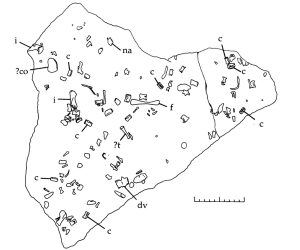
Headhunting
Firstly lets familiarise ourselves with choristoderes. Champsosaurus was a choristodere. “But you just said it was a rhynchocephalian!” Yes, confusing isn’t it! When the famous moustached Bone Wars veteran Edward Drinker Cope first described Champsosaurus in the 1870s he made it its own group, Choristodera, which he then put in Rhynchocephalia. In the following decades very few other choristoderes were found and the group sort of hop-scotched between being in Rhynchocephalia and being their own thing. By the time von Huene was working on Pachystropheus in the 1930s, choristoderes were rhynchocephalians again (though today they, yet again, aren’t…thanks taxonomy).
Although they were quite diverse, your average choristodere was slender, long-tailed and crocodile-like. Champsosaurus had a wide-backed but slender-snouted head similar to modern gharials (though they were not closely related; this is due to convergent evolution). Some had smaller, stouter heads, longer necks or variations thereof. They were pretty successful, surviving in warm freshwater environments from the Mesozoic all the way up to a little over 10 million years ago.
The oldest confirmed choristodere is the ~160 million year old Cteniogenys. It’s been estimated that choristoderes became their own group sometime in the Permian period, which ended ~250 million years ago. This massive gap between their theorised origin and first appearance in the fossil record is called a Ghost Lineage. After another decades-long silence following von Huene, in the 1990s more research was published on Pachystropheus also assigning it to Choristodera.
If correct, it would make Pachystropheus the oldest known choristodere by around 40 million years, effectively halving the length of the Ghost Lineage. But this classification has not been without controversy. One of the main reasons for this is frustratingly simple: despite its fossils being first described almost two hundred years ago and continuing to appear at multiple local sites like Aust, Holwell, Chipping Sodbury, Garden Cliff and Blue Anchor Point as well as Germany and possibly France, they are almost always a mess…and nobody has found Pachystropheus’ head yet!
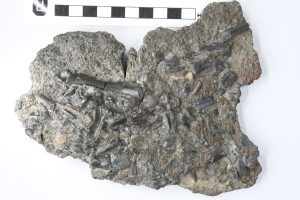
When it comes to identifying choristoderes the clues seem to be in their heads. Storrs et al., who classified Pachystropheus as a choristodere in the 90s, only had one skull bone described: the ectopterygoid, housed inside the upper jaw and looking a bit like the symbol of Star Trek’s Klingon Empire. More recently, Matsumoto et al. (2019) constructed a family tree of Choristodera for their newly-described Chinese species Coeruleodraco and listed a number of features that define the group. Most of these were in the skull…but not the ectopterygoid. There is also doubt over whether the ectopterygoid in question is even from Pachystropheus at all!
Another thing that throws a spanner in the works is where Pachystropheus lived. If you go to Aust Cliff you will see that the rocks change nearer the top. They go from a stark mass of deep red to varying shades of grey. To cut a ~40 million-year-long story short, during the Permian and Triassic England was part of the supercontinent Pangaea. Over time Pangaea broke up and sea levels rose. Aust records this change, with the red rocks being terrestrial and the grey rocks above being marine. The Penarth Group Pachystropheus comes from is in the grey bit.
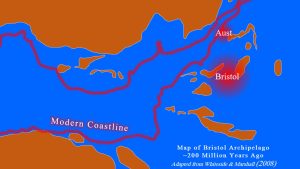
Its bones are found jumbled up with those of marine animals, even in coprolites (fossilised poo) left by sharks. A striking example of this was found at Hampstead Farm, containing two tail bones of Pachystropheus and a skull bone likely from the fish Saurichthys, possibly implying both were eaten in quick succession. Perhaps an unlucky Pachystropheus picked the wrong time to do some scavenging!
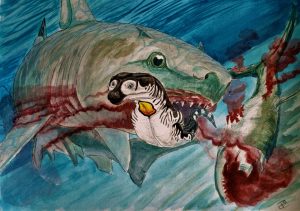
As mentioned earlier, every choristodere found so far has come from freshwater deposits, which doesn’t match Pachystropheus’ apparent habitat. In 2005 Müller et al. suggested that Pachystropheus was another kind of reptile called a thalattosaur in their description of Endennasaurus, a thalattosaur from Italy. Thalattosaurs not only lived in the sea but are known to have been around during the Triassic. It would also account for no Pachystropheus teeth having been found, as Endennasaurus didn’t have any. But absence of evidence is not always evidence of absence so this classification is also a bit up-in-the-air.
Outcast of Outcasts
So, what CAN we say about Pachystropheus after this patchy, convoluted journey through palaeontological history? Well, we know it lived around 208-201 million years ago at the end of the Triassic Period. We know that it was a reptile with a slender build, a likely body length of around a metre (though some estimates suggest it could grow to two metres or more. If it was a choristodere, it likely had a vaguely crocodilian long-snouted head. If it was a thalattosaur like Endennasaurus, the head would have been more pointy. We know it was found in coastal areas across what would one day become Western Europe, but at the time was a series of scattered islands surrounded by warm shallow seas. Without the crucial-but-missing head, there’s not much else to talk about!
To me, there’s something very charming and intriguing about this little local creature being so well-known while also being so poorly understood. It pops up in papers on Rhaetian-age rocks, and papers about choristoderes, but usually seems to be a case of “we keep finding this reptile but we don’t really know what it is”. You can access places where Pachystropheus is found, like Aust Cliff and Blue Anchor, pretty easily. So keep an eye out, maybe you could be the one to discover Pachystropheus’ head and solve its mysteries!
James Ormiston graduated from the Palaeontology & Evolution MSci at the University of Bristol in 2016. He is now a palaeoartist (@notsimro) and lab technician.
Article edited by Jacob Quinn.
References
Cross, S. R. R. et al. (2018) Microvertebrates from the basal Rhaetian Bone Bed (latest Triassic) at Aust Cliff, S.W. England. Proceedings of the Geologists’ Association. 129: 635-653
Cueille, M. et al. (2020) Fish and crab coprolites from the latest Triassic of the UK: From Buckland to the Mesozoic Marine Revolution. Proceedings of the Geologists’ Association. 131: 699-721
Duffin, C. (2019) Charles Moore and Late Triassic Vertebrates: History and Reassessment. The Geological Curator. 11 (2): 143-160
Matsumoto, R. et al. (2019) The first record of a nearly complete choristodere (Reptilia: Diapsida) from the Upper Jurassic of Hebei Province, People’s Republic of China. Journal of Systematic Palaeontology. 17: 1031-1048
Matsumoto, R. & Evans, S. E. (2010) Choristoderes and the freshwater assemblages of Laurasia. Journal of Iberian Geology. 36 (2): 253-274
Müller, J., Renesto, S. & Evans, S. E. (2005) The marine Diapsid Reptile Endennasaurus from the Upper Triassic of Italy. Palaeontology. 48 (1): 15-30
Nordén, K. K., Duffin, C. J. & Benton, M. J. (2015) A marine vertebrate fauna from the Late Triassic of Somerset, and a review of British placodonts. Proceedings of the Geologists’ Association. 126: 564-581
Storrs, G. W., Gower, D. J. & Large, N. F. (1996) The Diapsid Reptile, Pachystropheus rhaeticus, a probable Choristodere from the Rhaetian of Europe. Palaeontology. 39 (2): 323-349
Turner, S., Burek, C. V. & Moody, R. T. J. (2010) Forgotten women in an extinct saurian (man’s) world. Geological Society, London, Special Publications. 343: 111-153

